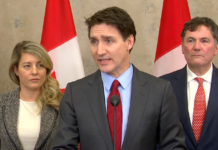Billions of dollars of public funds have been spent in recent years to compensate for alleged injustices committed in the past or to dramatically improve the present life chances of downtrodden Indigenous people.
According to Tom Flanagan, Professor Emeritus of Political Science and Distinguished Fellow, School of Public Policy, University of Calgary, governments have paid what could rightly be called “reparations” to Indian Bands for almost two decades under the misleading heading of Reconciliation. “Call it reparations by stealth,” he has opined.
This has included almost $5 billion in individual payments to those who attended Indian Residential Schools and $43.3 billion for children on reserves taken into foster care by welfare authorities.
Flanagan has pointed out the cost of claims approved thus far is $27.8 billion in individual payments, $31.9 billion for collective payments to improve local services, for a total of almost $60 billion. Claims now in progress will add significantly to these sums.
Going forward, the 2022 federal budget promised “to invest an additional $11 billion over six years to continue to support Indigenous children and families, and to help Indigenous communities continue to grow and shape their futures.”
Judging from previous spending, most of this money will have little positive impact on either “reconciliation” (reparation) for past errors or hastening socio-economic equality with non-Indigenous Canadians.

According to a damning report from the Parliamentary Budget Officer released in May, there is a huge disconnect between the government’s aspirations and the sums spent, on the one hand, and the actual consequences, on the other.
The PBO’s report on Crown-Indigenous Relations and Northern Affairs Canada and Indigenous Services Canada summarized the situation as follows: “The increased spending did not result in a commensurate improvement in the ability of these organizations to achieve the goals that they had set for themselves. Based on the qualitative review the ability to achieve the targets specified has declined.”
According to Ken Coates, distinguished fellow and director of the Indigenous Affairs program at the Macdonald-Laurier Institute, and a Canada Research Chair in Regional Innovation at the University of Saskatchewan:
“Canadians have become numb to reading about public expenditures on Indigenous peoples.… If Canada spends billions on Indigenous affairs, it must mean that we care deeply about First Nations, Métis and Inuit peoples. But it does nothing of the sort. While headlines emphasize dollar amounts, the statistics that tell the actual story of Indigenous well-being — around employment, health, housing conditions, suicide rates, violence and imprisonment, language, cultural revitalization — are much more sombre. When spending vast sums fails to make a substantial difference in many communities, the federal response is too often to double down and spend even more, in the absence of understanding what actually works to improve the lives of Indigenous peoples.”
The net effect of these failures within a national comparative perspective is that indigenous people on- and off-reserve continue to exhibit the highest rates of criminal behaviour and incarceration; the lowest incomes; the highest rates of unemployment, non-working population numbers, poverty, welfare dependency, alcohol and other drug addiction, and homelessness; the poorest housing; the highest rates of infant mortality; the lowest life expectancy; the highest disease and illness rates; the highest rates of suicides; the highest school dropout levels; the highest rates of child apprehension, fostering, and adoption; the highest levels of suicide and the highest rates of sexual abuse, the latter often fomented by the former; the highest rates of murdered and missing women; and the highest levels of drug overdoses.
Cat Lake Indian Reserve, a fly-in island community of just under 500 people in northern Ontario presents a typical case study of indigenous adversities.
The reserve has around 180 active registered participants in its opioid addiction programme, 36% of total population, according to Chief Russell Wesley.
As for housing, it’s not uncommon to have multiple families of up to 15 people, living in a home the size of a typical three-bedroom apartment. There are also significant health impacts associated with overcrowding, a leading cause of mould in homes. In 2019, more than three-quarters of the community’s housing was deemed unfit. A hundred children — almost half of those in the community — were diagnosed with respiratory diseases linked to black mould.

Like many other northern reserves, Cat Lake is impoverished. The average annual income in 2020 was $29,600 per person, a low figure given the high cost of living, with food and gas prices among the highest in Canada. The only store in town is run by the remnants of the historical North West Company, created in 1668.
Given its small size and isolation, the store charges more than $10 for a box of pasta and $9 for a litre of orange juice. A bag of salad is $11, and other fresh fruits and vegetables are akin to luxury items.
Families hunt and fish to augment food supplies and depend on a school nutrition programme, which provides fresh fruit and vegetables to hungry students.
Several themes emerge from these and other communities like them.
The overriding one is the deeply entrenched local-level assertion rooted in national narratives that colonial oppression and the long-gone residential school system are the source extant community adversity. All blame for current socio-economic problems, according to the prevailing narrative based on established wisdom, lies external to the depressed local communities or the lives of its residents. There is no grass-roots discussion of the ills of welfare dependency and little about the downside of federal government paternalism. Nor is there any challenge of how the debilitating norms and attitudes that prevail today regarding family life, self-reliance, personal responsibility, free will, and community cohesion, might be reformed from within.
Instead, well-meaning leaders like Chief Wesley always fall back on the same trope – “Residential school trauma introduces intergenerational trauma” – to explain all local social evils, including the underuse of the reserve’s adult education centre: “Chief Wesley said he’s brought in dozens of online education opportunities through partnerships with colleges, and yet, the centre sits empty due to low registration.”
It is also claimed that the already massive spending by the federal and provincial governments on Indian Band health and welfare, is simply not enough. The underlying assumption is that things would be different if only the government would be more forthcoming with dollars, billions more of them, in fact.
But there is never a whisper that the emperor has no clothes: how is it possible to achieve anything close to self-reliance, let alone widespread economic and social development, under an existing regime of 634 Indian Bands claiming to be “First Nations” when they are divided into over 3,000 reserves, most of them miniscule in size, scattered across a country with the world’s second largest land size.
Instead, Chief Wesley and his band council, like most of their counterparts across Canada, with the active encouragement of the federal government, are focused on restoring “old values through cultural and land-based programs that teach Anishinaabe culture, language and practices on the land, such as how to hunt and fish and clean the animals,” a naively sentimental socio-economic dead end if there ever was one. Meanwhile, only one in five working-age adults over 24 in Cat Lake has a high school diploma, according to Statistics Canada’s 2021 census, in a community with an 80% school dropout rate.
Instead of trying to improve school outcomes to meet Canada’s employment needs, the community has adopted “Land-based programs … modelled after ancestral teachings around hunting, trapping, fishing, and harvesting. They take ancestral land practices and infuse them with Anishinaabe language and spirituality. In Cat Lake, small-scale versions of these programs have taken place, with some students going out with the community’s land-based expert to learn how to trap and clean a rabbit.”
The band also wants “to open community-run shops, like a co-op and coffee shop, to compete with the Northern Store’s monopoly. They want to build a daycare centre, expand the school and partner with industry on resource development.”
All these cultural, social, and economic initiatives on an island lacking the inherent economic opportunities that would allow support of new business ventures would require large amounts of government funding with little prospect that they would lead to long-term economic growth.
The current Prime Minister’s father recognized that the reserve system operating under the framework of the apartheid Indian Act was both economically maladaptive and contrary the ideal of citizen equality. In his 1969 “White Paper,” Pierre Elliot Trudeau called for the step-by-step abolishment of the Indian Act and dismantling of the reserves (“ghettos,” as he called them):
“We have set the Indians apart as a race. We’ve set them apart in our laws…They are wards of the federal government …. I think that in a given society one section of the society cannot have a treaty with the other section of the society. We must be all equal under the laws and we must not sign treaties amongst ourselves…. this is the only basis on which I see our society can develop as equals.”
Trudeau viewed the abolition of separate Treaty Indian status as necessary to aboriginal future well-being and prosperity. Indigenous organizations, preoccupied as they still are today with their own narrow interests and privileges, vehemently objected so vociferously that Trudeau was forced to abandon his efforts to legislate an end to indigenous exceptionalism.
The terrible legacy of that retreat has continued to plague all Canadians, especially indigenous ones, to the present day.
Hymie Rubenstein is the editor of The REAL Indigenous Issues Newsletter and a retired professor of anthropology at The University of Manitoba.
Pim Wiebel worked for over three decades in indigenous community development and refugee resettlement and is a former Indian Residential School teacher.





















